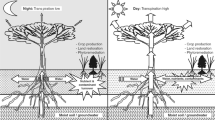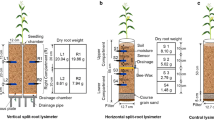Abstract
Hydraulic redistribution is the process where soil water is translocated by plant roots from wet to dry areas as it is drawn through xylem pathways by a water potential gradient. Hydraulic redistribution places soil water resources where they would otherwise not be, which results in a range of ecological and hydrological consequences. Although deep-rooted plants can transfer water up from depth into shallow soil layers, any localised ‘irrigation’ of neighbouring plants tends to be obscured by recovery of the very same water by the donor plants during daytime transpiration. A new intercropping system was recently trialled which eliminates transpiration by the donor plant through complete shoot removal in order to maximise hydraulic redistribution. In the absence of any transpiring shoots, the donor plants are left to wick water up from depth 24 hours a day via their root systems, to the benefit of neighbouring shallow-rooted crops. This system allows deeper-rooted ‘nurse plants’ to capture water that is out of reach of crops in a ‘water safety-net’ role, which may be of considerable benefit in water-scarce environments.
Similar content being viewed by others
References
Allen SC, Jose S, Nair PKR, Brecke BJ, Nkedi-Kizza P, Ramsey CL (2004) Safety-net role of tree roots: evidence from a pecan (Carya illinoensis K. Koch)-cotton (Gossypium hirsutum L.) alley cropping system in the southern United States. For Ecol Manage 192:395–407. doi:10.1016/j.foreco.2004.02.009
Brooks JR, Meinzer FC, Coulombe R, Gregg J (2002) Hydraulic redistribution of soil water during summer drought in two contrasting Pacific Northwest coniferous forests. Tree Physiol 22:1107–1117
Burgess SSO, Adams MA, Turner NC, Ong CK (1998) The redistribution of soil water by tree root systems. Oecologia 115:306–311
Burgess SSO, Bleby TM (2006) Redistribution of soil water by lateral roots mediated by stem tissues. J Exp Bot 57:3283–3291
Caldwell MM, Dawson TE, Richards JH (1998) Hydraulic lift—consequences of water efflux from the roots of plants. Oecologia 113:151–161
Dawson TE (1993) Hydraulic lift and water-use by plants—implications for water-balance, performance and plant-plant interactions. Oecologia 95:565–574
Hawkins HJ, Hettasch H, West AG, Cramer MD (2009) Hydraulic redistribution by Protea ‘Sylvia’ (Proteaceae) facilitates soil water replenishment and water acquisition by an understorey grass and shrub. Funct Plant Biol 36:752–760. doi:10.1071/fp09046
Hultine KR, Scott RL, Cable WL, Goodrich DC, Williams DG (2004) Hydraulic redistribution by a dominant, warm-desert phreatophyte: seasonal patterns and response to precipitation pulses. Funct Ecol 18:530–538
Horton JL, Hart SC (1998) Hydraulic lift: a potentially important ecosystem process. Trends Ecol Evol 13:232–235
Kulmatiski A, Beard KH, Verweij RJT, February EC (2010) A depth-controlled tracer technique measures vertical, horizontal and temporal patterns of water use by trees and grasses in a subtropical savanna. New Phytol 188:199–209. doi:10.1111/j.1469-8137.2010.03338.x
Lee JE, Oliveira RS, Dawson TE, Fung I (2005) Root functioning modifies seasonal climate. Proc Natl Acad Sci USA 102:17576–17581
Leffler AJ, Peek MS, Ryel RJ, Ivans CY, Caldwell MM (2005) Hydraulic redistribution through the root systems of senesced plants. Ecology 86:633–642
Lefroy EC, Hobbs RJ, O’Connor MH, Pate JS (1999) What can agriculture learn from natural ecosystems? Agrofor Syst 45:423–436
Ludwig F, Dawson TE, de Kroon H, Berendse F, Prins HHT (2003) Hydraulic lift in Acacia tortilis trees on an East African savanna. Oecologia 134:293–300
Ludwig F, Dawson TE, Prins HHT, Berendse F, de Kroon H (2004) Below-ground competition between trees and grasses may overwhelm the facilitative effects of hydraulic lift. Ecol Lett 7:623–631
Mitchell PJ, Veneklaas EJ, Lambers H, Burgess SSO (2007) Maintaining leaf water balance during summer water deficit: differential responses in turgor maintenance and variation in leaf structure among different plant functional types in south-western Australia. New Phytol 31:1791–1802
Prieto I, Martinez-Tilleria K, Martinez-Manchego L, Montecinos S, Pugnaire FI, Squeo FA (2010) Hydraulic lift through transpiration suppression in shrubs from two arid ecosystems: patterns and control mechanisms. Oecologia 163:855–865. doi:10.1007/s00442-010-1615-3
Richards JH, Caldwell MM (1987) Hydraulic lift: substantial nocturnal water transport between soil layers by Artemisia tridentata roots. Oecologia 73:486–489
Schoonmaker AL, Teste FP, Simard SW, Guy RD (2007) Tree proximity, soil pathways and common mycorrhizal networks: their influence on the utilization of redistributed water by understory seedlings. Oecologia 154:455–466. doi:10.1007/s00442-007-0852-6
Schulze ED, Caldwell MM, Canadell J, Mooney HA, Jackson RB, Parson D, Scholes R, Sala OE, Trimborn P (1998) Downward flux of water through roots (i.e. inverse hydraulic lift) in dry Kalahari sands. Oecologia 115:460–462
Sekiya N, Yano K (2004) Do pigeon pea and sesbania supply groundwater to intercropped maize through hydraulic lift? Hydrogen stable isotope investigation of xylem waters. Field Crop Res 86:167–173
Sekiya N, Araki H, Yano K (2010) Applying hydraulic lift in an agroecosystem: forage plants with shoots removed supply water to neighboring vegetable crops. Plant and Soil. doi:10.1007/s11104-010-0581-1
Smith DM, Jackson NA, Roberts JM, Ong CK (1999) Reverse flow of sap in tree roots and downward siphoning of water by Grevillea robusta. Funct Ecol 13:256–264
Van Noordwijk M, Cadisch G (2002) Access and excess problems in plant nutrition. Plant Soil 247:25–40
Van Noordwijk M, Lusiana B (1999) WaNuLCAS 1.0, a model of water, nutrient and light capture in agroforestry systems. Agrofor Syst 45:131–158
Walter H (1971) Natural savannahs as a transition to the arid zone. In: Burnett JH (ed) Ecology of tropical and subtropical vegetation. Oliver and Boyd, London, pp 238–265
Zou CB, Barnes PW, Archer S, McMurtry CR (2005) Soil moisture redistribution as a mechanism of facilitation in Savanna tree-shrub clusters. Oecologia 145:32–40. doi:10.1007/s00442-005-0110-8
Author information
Authors and Affiliations
Corresponding author
Additional information
Responsible Editor: Hans Lambers.
Rights and permissions
About this article
Cite this article
Burgess, S.S.O. Can hydraulic redistribution put bread on our table?. Plant Soil 341, 25–29 (2011). https://doi.org/10.1007/s11104-010-0638-1
Received:
Accepted:
Published:
Issue Date:
DOI: https://doi.org/10.1007/s11104-010-0638-1




